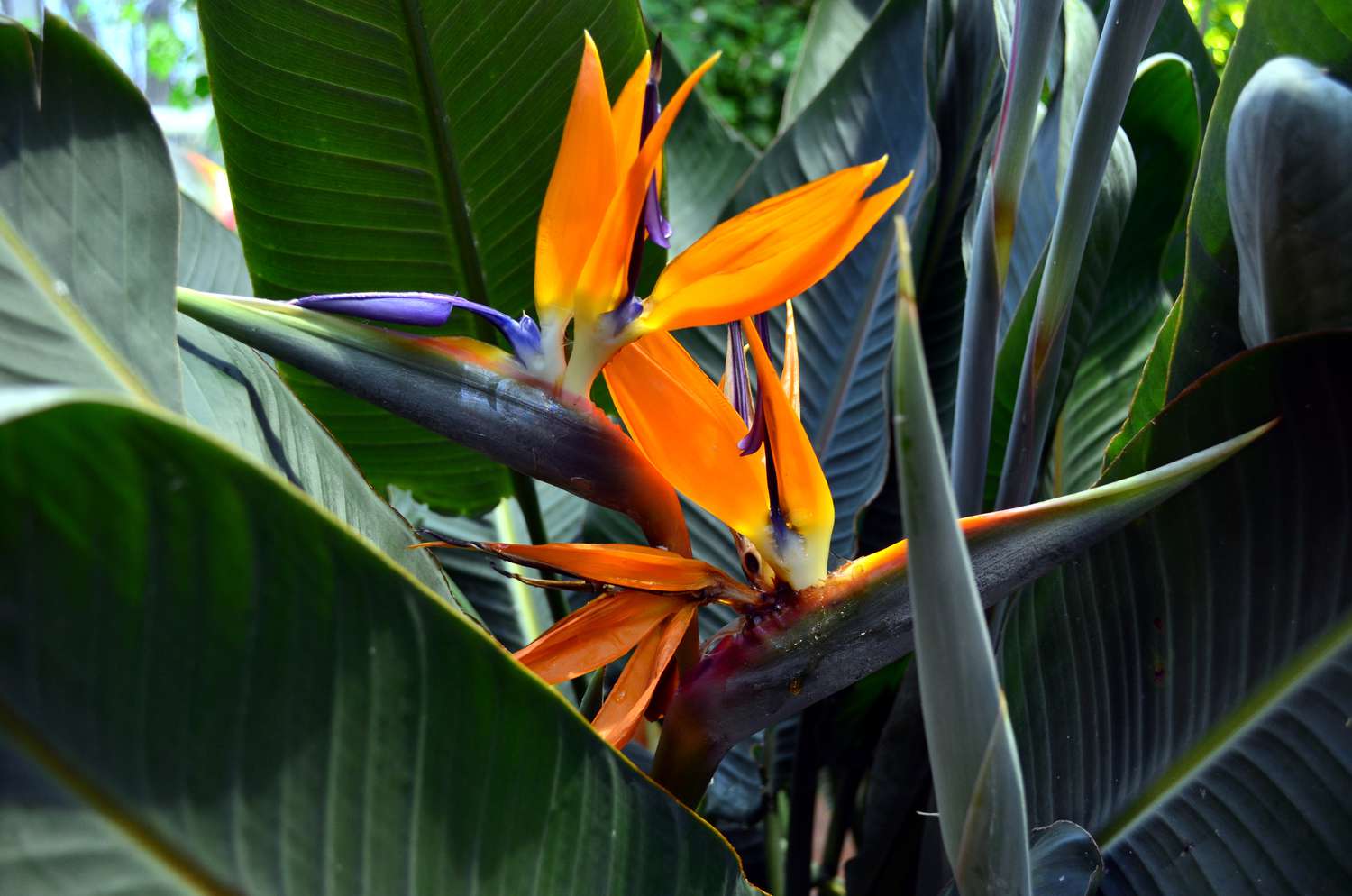
Bird of Paradise plants are known for their stunning, exotic flowers that resemble the plumage of tropical birds. These fascinating plants belong to the Strelitziaceae family and are native to the tropical regions of South Africa. Bird of Paradise plants have become popular additions to gardens and indoor spaces due to their unique beauty and vibrant colors.
In this article, we will explore 18 astonishing facts about Bird of Paradise plants that will leave you in awe of their fascinating characteristics. From their origins and symbolism to their growth patterns and care requirements, there is much to discover about these extraordinary botanical wonders. Whether you are a plant enthusiast, a gardener, or simply curious about the natural world, these facts will provide you with a deeper understanding and appreciation for the Bird of Paradise plants.
Key Takeaways:
- The Bird of Paradise, native to Papua New Guinea, has over 40 species, each with unique courtship displays and vibrant plumage. Its acrobatic courtship displays and vital role in seed dispersal make it a symbol of beauty and elegance.
- The Bird of Paradise, with its stunning beauty and cultural significance in Papua New Guinea, faces conservation challenges due to habitat loss. Its unique courtship displays and vocalizations have fascinated scientists and naturalists for centuries.
The Bird of Paradise is native to the rainforests of Papua New Guinea.
The vibrant and enchanting Bird of Paradise, scientifically known as Paradisaea, is indigenous to the lush rainforests of Papua New Guinea. It is renowned for its captivating beauty and unique courtship displays.
There are over 40 different species of Bird of Paradise.
With a wide variety of species, each Bird of Paradise boasts its own distinct appearance and behavior. From the exquisite plumes of the Greater Bird of Paradise to the intricate dances of the King Bird of Paradise, each species is a testament to the wonders of nature.
The male Bird of Paradise is known for its elaborate and mesmerizing courtship displays.
The male Bird of Paradise goes to great lengths to attract a mate. With its vibrant colors, intricate feather patterns, and impressive dances, it puts on a magnificent show that is unmatched in the avian world.
The Bird of Paradise has one of the most unique mating rituals in the animal kingdom.
During courtship, the male Bird of Paradise meticulously clears a space on the forest floor and creates an intricate display area adorned with leaves and other materials. He then performs a series of flamboyant dances and calls to capture the attention of the female.
The Bird of Paradise is known for its vibrant and colorful plumage.
With its striking hues and intricate feather patterns, the Bird of Paradise is a true marvel to behold. From rich blues and vibrant greens to fiery reds and brilliant yellows, their feathers are a testament to the wonders of nature’s palette.
The male Bird of Paradise goes through an elaborate molting process.
As part of their annual molt, the male Bird of Paradise sheds its old feathers and grows new ones. This process ensures that their plumage remains vibrant and pristine for their courtship displays.
The female Bird of Paradise is more discreet in appearance compared to the male.
While the male Bird of Paradise steals the show with its dazzling plumage and intricate dances, the female is more understated in her appearance. She tends to have a more camouflaged plumage, allowing her to blend into her surroundings for protection.
The Bird of Paradise has a wide range of diet comprising fruits, insects, and small vertebrates.
These remarkable birds have an omnivorous diet, feasting on a variety of fruits, insects, and even small vertebrates. This diverse diet provides them with the necessary nutrients to thrive in their natural habitat.
The Bird of Paradise has evolved unique adaptations for survival.
Over time, the Bird of Paradise has developed various adaptations to thrive in its rainforest habitat. These include specialized beaks for feeding on different types of food, strong feet for climbing and perching, and intricate vocalizations for communication.
The Bird of Paradise plays a vital ecological role in seed dispersal.
As they feed on fruits and nectar, the Bird of Paradise inadvertently assists in seed dispersal. The seeds of the plants they consume are often excreted in different locations, contributing to the survival and growth of various plant species in the rainforest.
The Bird of Paradise has cultural significance in Papua New Guinea.
In Papua New Guinea, the Bird of Paradise holds great cultural significance. Its stunning beauty and unique behaviors have inspired indigenous art, dances, and traditional ceremonies that celebrate the bird’s enchanting presence in their lives.
The Bird of Paradise is known for its acrobatic displays.
During courtship, the male Bird of Paradise engages in acrobatic maneuvers, such as hanging upside down or contorting its body in intricate ways. These displays are both visually mesmerizing and a testament to the bird’s physical prowess.
The breeding season of the Bird of Paradise varies among different species.
While some species of Bird of Paradise have specific breeding seasons, others can mate throughout the year. This variation ensures that there is always a fascinating courtship display happening somewhere in the rainforest.
The Bird of Paradise is a symbol of beauty and elegance.
With its vibrant colors, graceful movements, and captivating displays, the Bird of Paradise has come to symbolize beauty and elegance in the avian world. Its presence in the rainforest adds a touch of enchantment to the already breathtaking ecosystem.
The elaborate courtship displays of the Bird of Paradise are passed down through generations.
The courtship rituals and dances of the Bird of Paradise are learned behaviors that are passed down from one generation to another. Young males observe and imitate the displays of the older males, ensuring that these remarkable behaviors continue to thrive.
The different species of Bird of Paradise have distinct vocalizations.
In addition to their striking visual displays, the Bird of Paradise is also known for its remarkable vocalizations. Each species has its own unique calls and songs, which play an essential role in courtship, territorial communication, and social interactions.
The Bird of Paradise has fascinated scientists and naturalists for centuries.
Ever since its discovery, the Bird of Paradise has captured the imagination of scientists and naturalists. Their beauty, intricate behaviors, and unique adaptations have been the subject of extensive research, contributing to our understanding of avian evolution and ecology.
The Bird of Paradise faces conservation challenges.
Like many species residing in the rainforests, the Bird of Paradise faces threats from habitat loss and degradation. Conservation efforts are crucial for preserving these astonishing birds and their delicate ecosystems for future generations.
Conclusion
In conclusion, bird of paradise plants are truly remarkable with their stunning beauty and unique characteristics. From their captivating flowers to their ability to attract birds and insects, these plants add a touch of exotic elegance to any garden or indoor space. They are not only eye-catching but also have interesting adaptations and survival strategies that make them stand out among other plants.If you’re looking to enhance the aesthetic appeal of your surroundings or simply want to immerse yourself in the wonders of nature, adding a bird of paradise plant to your collection is a fantastic choice. With their vibrant colors, intricate shapes, and intriguing behaviors, these plants are sure to leave you in awe.So, whether you’re a nature enthusiast, a gardening enthusiast, or simply someone who appreciates the beauty of the natural world, exploring the astonishing facts about bird of paradise plants will surely deepen your understanding and appreciation for these magnificent botanical wonders.
FAQs
Q: How often should I water my bird of paradise plant?
A: Bird of paradise plants prefer to be kept evenly moist, but not soggy. It is recommended to water them when the top inch of soil feels dry and provide enough water to thoroughly saturate the root zone.
Q: Can bird of paradise plants tolerate direct sunlight?
A: Yes, bird of paradise plants thrive in bright, indirect sunlight but can also tolerate full sun conditions. However, it’s important to gradually acclimate them to direct sunlight to avoid burning their leaves.
Q: How often should I fertilize my bird of paradise plant?
A: It is advisable to fertilize bird of paradise plants once every two to three months during the growing season (spring and summer) using a balanced, slow-release fertilizer. Be sure to follow the instructions on the fertilizer package for proper application.
Q: How tall can bird of paradise plants grow?
A: Depending on the species and growing conditions, bird of paradise plants can reach heights of up to 5-6 feet indoors and up to 20 feet outdoors in their natural habitat.
Q: Is bird of paradise plant toxic to pets?
A: Yes, bird of paradise plants are considered toxic to cats and dogs if ingested. It is advisable to keep them out of reach of pets or consider opting for pet-friendly plant alternatives.
From their vibrant plumage to elaborate courtship displays, Bird of Paradise never cease to amaze. Delving deeper into specific species reveals even more astonishing facts. Uncover the secrets behind Strelitzia Reginae's unique appearance and behavior. Explore surprising details about Bird of Paradise flowers' intricate blooms and pollination processes. Marvel at the sheer size and majesty of Giant Bird of Paradise, towering over their tropical habitats. Each species holds its own set of fascinating characteristics waiting to be discovered.
Was this page helpful?
Our commitment to delivering trustworthy and engaging content is at the heart of what we do. Each fact on our site is contributed by real users like you, bringing a wealth of diverse insights and information. To ensure the highest standards of accuracy and reliability, our dedicated editors meticulously review each submission. This process guarantees that the facts we share are not only fascinating but also credible. Trust in our commitment to quality and authenticity as you explore and learn with us.


